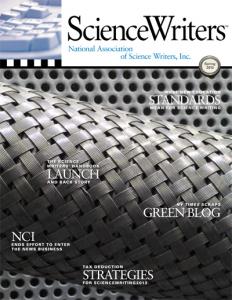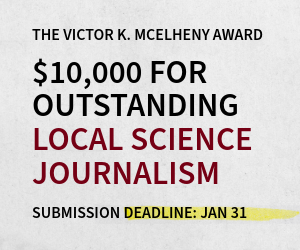Academic research relevant to the workaday world of science writing
By Ben Carollo and Rick Borchelt
Do you trust me?
We (that is, the authors of this article) often find ourselves discussing the role of trust in our work environment. Whether we are trying to figure out how to avoid participating in a “trust fall” activity at an office team-building event or debating how much our key stakeholders trust the scientific information that they see in the media, trust is a recurring theme in our professional lives. We think that trust is on your minds as well. Members of the NASW community regularly express the notion that one reason that journalistic integrity is so critical is in order to maintain trust with the publics who rely on us for information about science. With all of the time our community spends focusing on trust, we thought it would be worth exploring some recent research that can provide some insight into how issues of trust play out in science communication.Gauchat, Gordon. Politicization of Science in the Public Sphere: A Study of Public Trust in the United States, 1974 to 2010. American Sociological Review 77(2) (2012) 167-187.
In this article, Gauchat uses data from the 1974 to 2010 General Social Survey to study how trust in science changed over time for groups of people with common characteristics. He focuses primarily on whether there was evidence that political ideological leanings influenced trust in science and science institutions. He specifically investigated responses to the question about trust in the scientific community and respondents’ demographic responses. Gauchat observed that group differences in trust in science generally stay stable over time, except for the group of people who identified themselves as conservatives. For this period, conservatives began with the highest level of trust in science and science institutions but ended with the lowest levels when compared to liberals and moderates. Of note, the patterns that emerged related to science were unique as compared to other secular institutions.
Gauchat explains the anomaly by noting that, in the political arena, scientific credibility is tied to perceptions of the scientific information’s objectivity. He discusses how public trust in science stems from acknowledging that some third party has specialized knowledge about something beyond general comprehension, and that this is indeed required in a differentiated society that promotes specialization. Accordingly, maintaining social credibility of science requires that there is both continued trust in scientific independence as well as the notion that a specialized society where scientists are encouraged to challenge old assumptions and generate new ideas. When looking at the social values end of the spectrum, it appears that as the conservative political movement more closely aligned with the religious right, the scientific emphasis on independent inquiry put science at odds with a political philosophy that places an emphasis on traditionalism. This, Gauchat posits, begins the breakdown in trust.
Equally important to note, he says, is how science has changed over time. As science became more entrenched in political debates, regulatory science organizations became increasingly important to the debate. Regulatory science cannot be separated from policy management, and therefore science has been dragged into inherently ideological discourse. The increased profile of regulatory science additionally changes the narrative about the value of science from one about promoting innovation and progress to one about reducing risk and intrusive government. This changing narrative could contribute to the erosion of perceptions of scientific independence, with trust as collateral damage. This, of course, would have a greater impact on the political party most closely aligned with regulated industries. There is a hint of irony in this situation, in that it appears that science may be suffering due to its own success.
The author suggests that this evolution may result in a reorganization of how science is integrated into the policymaking sphere. In the meantime, those of us who tell the story of science face additional obstacles in telling that story to certain audiences. Perhaps reaching some people is more effort that it is worth, but there are a lot of people out there who do still trust science, and they are the field’s best ambassadors, so it is more imperative now than ever that they are able and motivated to share our stories.
Brewer, Paul R. and Barbara L. Ley. Whose Science Do You Believe? Explaining Trust in Sources of Scientific Information About the Environment. Science Communication 35 (2013) 115-137.
The authors of this paper investigate why individuals trust some sources of information over others, specifically in relation to information about the environment. The general assumption in the paper is that most individuals do not have the ability to absorb all of the basic facts of a scientific situation and thus rely on others to digest the information for them. There is a set of heuristics that drives which sources of information are trusted, which suggests that these heuristic factors ultimately drive individuals to a set of information that they accept as facts. In the environmental debate, minority opinions often persist as legitimate arguments, so insight into this could prove useful.
The researchers sought to answer seven research questions that focused on the extent to which political ideology, support for environmental regulation, attendance at religious services, trust in people, trust in government, trust in scientists, and demographics predict trust in an individual’s “sources of interest.” The data used to answer these questions was collected during a survey conducted in Milwaukee, Wis., between November 2009 and March 2010. This, of course, does introduce some limits to the extent to which findings from this study can be generalized to apply to a larger population.
The study first identifies which sources of science information were deemed to be the most trusted. The most trusted source for science information (by a statistically significant amount of 46 percent of respondents) was science television programming, such as Nova or programming on the Discovery Channel. University scientists were rated as the next most trusted source, followed by science magazines. Next in line were science websites and blogs associated with environmental organizations. Tied on the list for last place were television news and local daily newspapers, with only 14 percent of people reporting trust in these sources.
Brewer and Ley also analyze how the aforementioned factors affect trust in these various sources. They found that political ideology and religiosity predicted levels of trust in scientists, with conservatives and the most religious respondents indicating less trust. Political ideology also predicted level of trust in environmental organizations, with conservatives indicating lower levels of trust. Moreover, general support for environmental regulation predicted increased trust in all sources except science media. These findings indicate that there is potential for information about science to get lost in ideological societal debates. The authors’ analysis also indicates that there may be a “spillover” effect between trust in scientists and trust in information sources as indicated by a positive association between these variables.
Smith, Nicholas and Helene Joffe. How the public engages with global warming: A social representations approach. Public Understanding of Science 22 (2013) 16-32.
This final study looks at subconscious factors that indicate how people make sense of global warming. Underlying the study is the social representation theory, which suggests that rather than relying on heuristics that we rationally calculate, people use socially available symbols, metaphors, and iconic images to help make sense of unfamiliar issues. In the study, 56 Londoners were asked to draw or write their “first thoughts or feelings” about global warming when prompted. They were asked to fill four boxes, each with a distinct thought. Participants were then interviewed to explore what they wrote or drew.
Some 93 percent of all first free associations and 76 percent of all other free associations fell into 13 categories. The participants’ first thoughts often reflected images used by the British press in their coverage of global warming. The majority of all free associations could be grouped into two categories: causes or impacts of global warming. Impacts accounted for 67 percent of first responses and 53 percent of all subsequent responses. The majority of these images reflected images that the British press used in their coverage of global warming, indicating that imagery they saw in the media inform the perceptions most people hold about global warming.
Moreover, the interviews identified series of dyads by which individuals process global warming. First was the “self/other” (or us versus them) dyad, which is reflected in people thinking about smoke stacks, melting glaciers, and recycling bins. There was also a “natural/unnatural” dyad associated with romanticized ideas of what people view as an ideal pre-global warming state. Finally, there was the “certainty/uncertainty” dyad that was related to images of the ozone hole and associations with sunburn and skin cancer. These dyads are especially important, because this suggests that people are processing the images presented in the media with other sources of context in their everyday life to make sense of the information. This structure in turn influences how individuals engage other people in conversations about the issue, and a dyadic structure of “this or that” provides an ideal construct to build an opinion for engaging in such debates.
Though not explored by the authors of this paper, we find the implications of their findings to be particularly interesting when compared to the insights offered in the previous two papers. Smith and Joffe’s work underscores how factors well beyond rational thought influence perceptions of science information. If there is any overlap in the characteristics of the populations of London and Milwaukee, we both found it startling to see the extent to which the primary influence in people’s perceptions of global warming comes from media images that are said to be the least trustworthy sources. Whether it is a political view or a bad experience in middle school biology class, all of these cultural cues have an impact on how our audiences perceive — and share with others — the stories we tell about science.
Editor’s note: With this issue we bid farewell to co-author Ben Carollo, who is leaving the National Institutes of Health for the Office of the Comptroller of the Currency. Many thanks to Ben for his valuable contributions to this column. He will be missed.
Scholarly Pursuits features articles from the social science research community in the United States and abroad. If you read an article you think would make a good candidate for this column, send it along to rickb@nasw.org.
Ben Carollo leads the issues analysis and response team at the National Cancer Institute at NIH. Rick Borchelt is special assistant for public affairs to the director at the National Cancer Institute at NIH.




